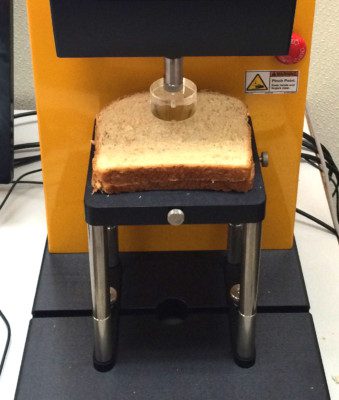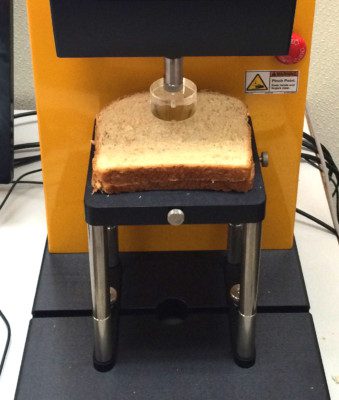How is resilience measured?
Resilience of bread and other baked products can be assessed using subjective and objective methods:
Subjective methods. The hinge test has been used by bakers to visually assess the resilience of bread. Using this test, a slice of bread is folded symmetrically along its middle and its resilience is estimated by observing the fissure along the fold line. Stale bread shows large fissures indicating low resilience while fresh bread results in no (minimum) fissures (Figure 1).

Figure 1: fresh vs. stale bread to show the importance of resilience.
Objective methods. Texture profile analysis (TPA) is a double-compression test often used in quantifying resilience and other textural parameters of baked products (Figure 2). It also provides a force/probe travel distance curve from which such textural properties are assessed. Resilience is determined automatically by dividing the area during probe withdrawal from the first compression by the area of the first compression.
This test is an indication of how hard a product works to regain its original shape. Because TPA emulates how samples of bread (or other materials) behave when chewed, meaningful test outcomes are only possible when TPA data are reconciled with sensory testing.3,5,6,7

Figure 2: a slice of bread being tested on a texture analyzer.
Application
Resilience is correlated with the extent of staling. Typically, the fresher the bread, the higher is its resilience, while stale bread shows little or no resilience. Freshly baked goods are expected to be soft to the touch, well-aerated and springy. Staling makes the crumb structure or internal matrix stiffer or firmer and more brittle (crumbly) over time.5
It is generally higher in baked goods with chewy texture. Unlike breads, cakes are not considered to have a chewy character, thus their low resilience. The resilience of bread is directly proportional to its springiness (the height to which the food recovers during the time between the end of the first bite and the start of the second bite).6 The more resilient the bread crumb, the more springy it is. These two properties are associated with product freshness.
The higher the moisture content of the product in its fresh state, the more prominent the changes upon staling. Breads, yeast-raised bakery products and cakes stale more than cookies and crackers which have lower initial moisture levels.
Changes in the resilient character of baked goods are a function of formulation variations and processing conditions. Processes involved in reduced resilience—staling and crumb firming—include starch retrogradation, modification of the gluten structure and subsequent moisture redistribution and loss.2,5
Factors that affect the resilience of bread include:2,5
- Protein content of wheat flour
- Dough hydration level (water absorption of flour). Key for product expansion during oven spring.
- Amount of sugars in formulation
- Level of fiber or bran inclusion in formula
- Moisture content of baked good according to baking conditions
- Levels of dough conditioners or antistaling agents such as amylases (bacterial, fungal, cereal), lipases and hemicellulases, and emulsifiers
- Air incorporation during mixing (key for cell structure and crumb grain)
- Gluten structure development
- Degree of leavening or gassing during fermentation
References
- Resilience. Total Materia (Materials Database) http://www.totalmateria.com/articles/Art41.htm. Accessed 11 August 2018.
- Sahi, S.S., Little, K., and Ananingsih, V.K. “Quality Control” Bakery Products Science and Technology, 2nd edition, John Wiley & Sons, Ltd, 2014, pp. 490–509.
- Van Vliet, T. “Fracture and Yielding Behavior” Rheology and Fracture Mechanics of Foods, CRC Press, Taylor & Francis Group, LLC, 2014, pp. 47–79.
- De Rovira, D. “E” Dictionary of Flavors, 3rd edition, John Wiley & Sons Ltd, 2017, p. 100.
- Cauvain, S.P. “Improving the texture of bread” Texture in Food Volume 2: Solid foods, Woodhead Publishing Ltd and CRC Press LLC, 2004, pp. 432–450.
- Van Vliet, T. “Cellular Materials” Rheology and Fracture Mechanics of Foods, CRC Press, Taylor & Francis Group, LLC, 2014, pp. 291–299.
- Fiszman, S.M., Sanz, T., and Salvador, A. “Instrumental Assessment of the Sensory Quality of Baked Goods” Instrumental Assessment of Food Sensory Quality: A Practical Guide, Woodhead Publishing Limited, 2013, pp. 374–402.

